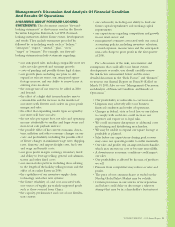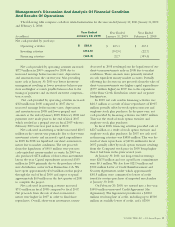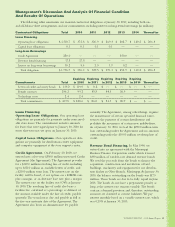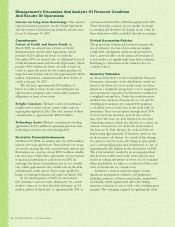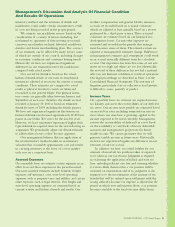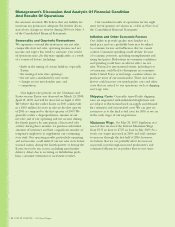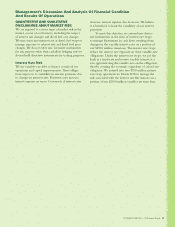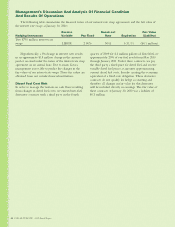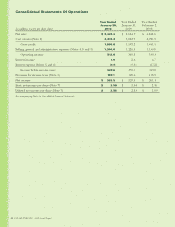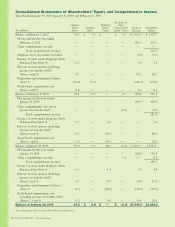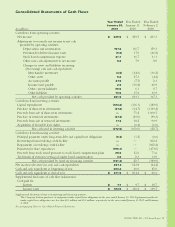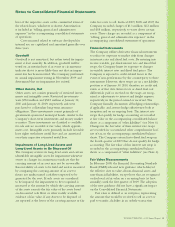Dollar Tree 2009 Annual Report Download - page 25
Download and view the complete annual report
Please find page 25 of the 2009 Dollar Tree annual report below. You can navigate through the pages in the report by either clicking on the pages listed below, or by using the keyword search tool below to find specific information within the annual report.
Management’s Discussion And Analysis Of Financial Condition
And Results Of Operations
workers’compensationandgeneralliabilityinsurance
accruals are recorded based on actuarial valuations
whichareadjustedatleastannuallybasedonareview
performed by a third-party actuary. These actuarial
valuations are estimates based on our historical loss
development factors. Certain other expenses are
estimated and recorded in the periods that manage-
ment becomes aware of them. The related accruals are
adjustedasmanagement’sestimateschange.Differences
inmanagement’sestimatesandassumptionscouldresult
in an accrual materially different from the calculated
accrual. Our experience has been that some of our esti-
mates are too high and others are too low. Historically,
the net total of these differences has not had a material
effectonournancialconditionorresultsofoperations.
OurlegalproceedingsaredescribedinNote4ofthe
Consolidated Financial Statements. The outcome of
litigation, particularly class or collective action lawsuits,
isdifculttoassess,quantifyorpredict.
Income Taxes
On a quarterly basis, we estimate our required income
tax liability and assess the recoverability of our deferred
tax assets. Our income taxes payable are estimated based
on enacted tax rates, including estimated tax rates in
states where our store base is growing, applied to the
income expected to be taxed currently. Management
assesses the recoverability of deferred tax assets based
on the availability of carrybacks of future deductible
amountsandmanagement’sprojectionsforfuture
taxableincome.Wecannotguaranteethatwewill
generate taxable income in future years. Historically,
wehavenotexperiencedsignicantdifferencesinour
estimates of our tax accrual.
Inaddition,wehavearecordedliabilityforour
estimate of uncertain tax positions taken or expected
tobetakeninourtaxreturns.Judgmentisrequired
in evaluating the application of federal and state tax
laws, including relevant case law, and assessing whether
it is more likely than not that a tax position will be
sustainedonexaminationand,ifso,judgmentisalso
required as to the measurement of the amount of tax
benetthatwillberealizeduponsettlementwiththe
taxingauthority.Incometaxexpenseisadjustedinthe
period in which new information about a tax position
becomesavailableorthenaloutcomediffersfrom
inventory method and the estimates of shrink and
markdowns could, under certain circumstances, result
in costs not being recorded in the proper period.
Weestimateourmarkdownreservebasedonthe
consideration of a variety of factors, including, but
not limited to, quantities of slow moving or seasonal,
carryover merchandise on hand, historical markdown
statistics and future merchandising plans. The accuracy
of our estimates can be affected by many factors, some
of which are outside of our control, including changes
in economic conditions and consumer buying trends.
Historically,wehavenotexperiencedsignicant
differences in our estimated reserve for markdowns
compared with actual results.
Our accrual for shrink is based on the actual,
historical shrink results of our most recent physical
inventoriesadjusted,ifnecessary,forcurrenteconomic
conditions. These estimates are compared to actual
results as physical inventory counts are taken and
reconciled to the general ledger. Our physical inven-
torycountsaregenerallytakenbetweenJanuaryand
September of each year; therefore, the shrink accrual
recordedatJanuary30,2010isbasedonestimated
shrinkformostof2009,includingthefourthquarter.
Wehavenotexperiencedsignicantuctuationsin
historicalshrinkratesbeyondapproximately10-20basis
pointsinourDollarTreestoresforthelastfewyears.
However, we have sometimes experienced higher than
typical shrink in acquired stores in the year following an
acquisition.Weperiodicallyadjustourshrinkestimates
to address these factors as they become apparent.
Our management believes that our application of
the retail inventory method results in an inventory
valuation that reasonably approximates cost and results
in carrying inventory at the lower of cost or market
each year on a consistent basis.
Accrued Expenses
On a monthly basis, we estimate certain expenses in an
effort to record those expenses in the period incurred.
Our most material estimates include domestic freight
expenses, self-insurance costs, store-level operating
expenses, such as property taxes and utilities, and certain
other expenses, such as legal reserves. Our freight and
store-level operating expenses are estimated based on
current activity and historical trends and results. Our
DOLLARTREE,INC.•2009AnnualReport23


